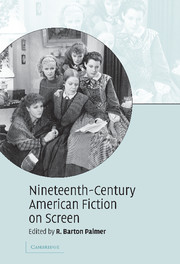Book contents
- Frontmatter
- Contents
- List of illustrations
- Notes on contributors
- Acknowledgments
- Introduction
- 1 A very American fable: the making of a Mohicans adaptation
- 2 Romancing the letter: screening a Hawthorne classic
- 3 The movies in the Rue Morgue: adapting Edgar Allan Poe for the screen
- 4 Readapting Uncle Tom's Cabin
- 5 Screening authorship: Little Women on screen 1933–1994
- 6 Melville's Moby-Dick and Hollywood
- 7 Screening male sentimental power in Ben-Hur
- 8 John Huston's The Red Badge of Courage
- 9 Translating Daisy Miller
- 10 Jane Campion's The Portrait of a Lady
- 11 The Europeans – and the Americans
- 12 Sister Carrie becomes Carrie
- 13 Hollywood and The Sea-Wolf
- 14 An untypical typicality: screening Owen Wister's The Virginian
- Filmography
- Index
5 - Screening authorship: Little Women on screen 1933–1994
Published online by Cambridge University Press: 22 December 2009
- Frontmatter
- Contents
- List of illustrations
- Notes on contributors
- Acknowledgments
- Introduction
- 1 A very American fable: the making of a Mohicans adaptation
- 2 Romancing the letter: screening a Hawthorne classic
- 3 The movies in the Rue Morgue: adapting Edgar Allan Poe for the screen
- 4 Readapting Uncle Tom's Cabin
- 5 Screening authorship: Little Women on screen 1933–1994
- 6 Melville's Moby-Dick and Hollywood
- 7 Screening male sentimental power in Ben-Hur
- 8 John Huston's The Red Badge of Courage
- 9 Translating Daisy Miller
- 10 Jane Campion's The Portrait of a Lady
- 11 The Europeans – and the Americans
- 12 Sister Carrie becomes Carrie
- 13 Hollywood and The Sea-Wolf
- 14 An untypical typicality: screening Owen Wister's The Virginian
- Filmography
- Index
Summary
“We haven't got father, and shall not have him for a long time,” says Jo sadly as the four March sisters cluster around the family hearth at the start of Little Women (1868). From its very first page, Louisa May Alcott's Little Women is demonstrably a book about women existing in a world without men. Framed by the action of the American Civil War, the story creates a nineteenth-century space in which women can legitimately take on male roles while the able-bodied breadwinners – husbands, fathers, sons, and lovers – are away from home at the battlefields. As the sisters gather at the fireside in an act of communal reading to hear the letter from father who is “far away, where the fighting was” (11), the text dramatically illustrates the importance of the written word that gives presence to what is absent.
This chapter examines the cinematic representation of this dysfunctional world and the accompanying exploration of female autonomy in Little Women. In this context, it considers, too, the specific role of writing and reading in the novel as offering a route to female independence, both mental and material, and the ambivalent treatment this receives on screen. For whereas the novel is packed with literary allusions and forcefully conveys the potency of literature as a survival mechanism, film has tended to present Little Women in a much milder light as a sentimental story for girls, its subject that of the American family and the socialization and triumph of its unruly heroine.
- Type
- Chapter
- Information
- Nineteenth-Century American Fiction on Screen , pp. 77 - 93Publisher: Cambridge University PressPrint publication year: 2007

